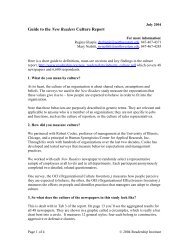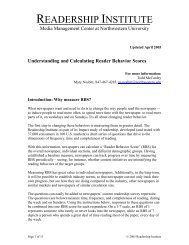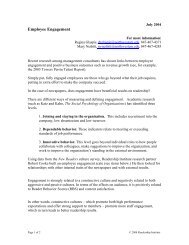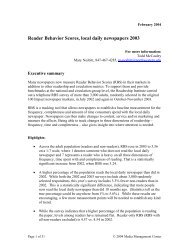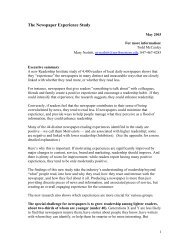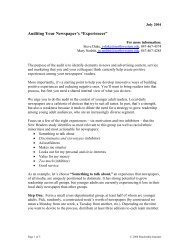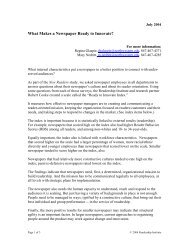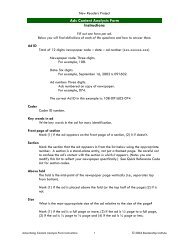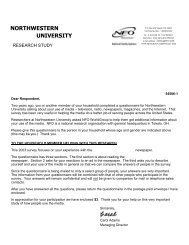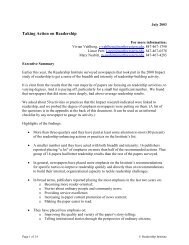U.S. Daily Newspaper Readership During the War with Iraq
U.S. Daily Newspaper Readership During the War with Iraq
U.S. Daily Newspaper Readership During the War with Iraq
You also want an ePaper? Increase the reach of your titles
YUMPU automatically turns print PDFs into web optimized ePapers that Google loves.
Competitive environment<br />
<strong>Newspaper</strong>s today operate in a crowded media environment. Not only are <strong>the</strong>re many<br />
media platforms but fragmentation means more choices <strong>with</strong>in each platform. In this<br />
environment how did newspapers fare? Did <strong>the</strong>y rise above o<strong>the</strong>r media and be<br />
perceived as uniquely valuable?<br />
Consumers were asked to choose which medium <strong>the</strong>y thought best describes each of<br />
nine different perceptions:<br />
1. …my source for <strong>the</strong> latest news<br />
2. …provides <strong>the</strong> most complete information<br />
3. …<strong>the</strong> most accurate source of information<br />
4. …helps me understand what is going on<br />
5. …<strong>the</strong> most engaging<br />
6. …provides <strong>the</strong> best expert analysis<br />
7. …my primary source of news<br />
8. …has <strong>the</strong> greatest variety of viewpoints<br />
9. …<strong>the</strong> best guide to o<strong>the</strong>r sources of information<br />
Overall, television scored highest on all perceptions. In only one instance was <strong>the</strong><br />
competition close, <strong>with</strong> newspapers and <strong>the</strong> Internet scoring almost as high as television<br />
on “<strong>the</strong> best guide to o<strong>the</strong>r sources of information.”<br />
These findings point out a blurring of <strong>the</strong> difference between objective reality and how it<br />
is perceived. For instance, an objective measure might well find that newspapers were<br />
more factually accurate than o<strong>the</strong>r media, but in consumers’ minds, television seemed<br />
far more accurate. An implication of this is <strong>the</strong> need to better promote newspapers’<br />
strengths, especially those that really make a difference to consumers.<br />
It is unrealistic to imagine that newspapers could ever dominate some perceptions –<br />
such as “my source for latest news” and “<strong>the</strong> most engaging.” But newspapers could<br />
have <strong>the</strong> substance, <strong>the</strong> packaging and <strong>the</strong> marketing to show more strongly, if not to<br />
dominate, <strong>the</strong> remaining perceptions. In those areas, newspapers are not “naturally” at<br />
a disadvantage – <strong>the</strong>y can choose to excel or to fall behind.<br />
Source for <strong>the</strong> latest news…<br />
RBS Age Gender<br />
% Overall Light Medium Heavy 60 Men Women<br />
<strong>Newspaper</strong> 7.5 1.1 8.3 13.3 4.7 7.9 8.7 5.1 9.7<br />
Television 74.0 73.7 76.2 72.4 72.1 71.5 82.2 71.1 76.6<br />
Radio 10.0 11.9 8.6 9.1 8.2 12.0 7.0 11.9 8.2<br />
News magazine 0.0 0.0 0.0 0.0 0.0 0.0 0.0 0.0 0.0<br />
www 7.6 11.6 6.1 4.8 13.7 7.7 1.7 10.7 4.7<br />
None 1.0 1.7 0.8 0.3 1.3 0.9 0.4 1.2 0.7<br />
Base: 1244<br />
14 of 20 © <strong>Readership</strong> Institute



